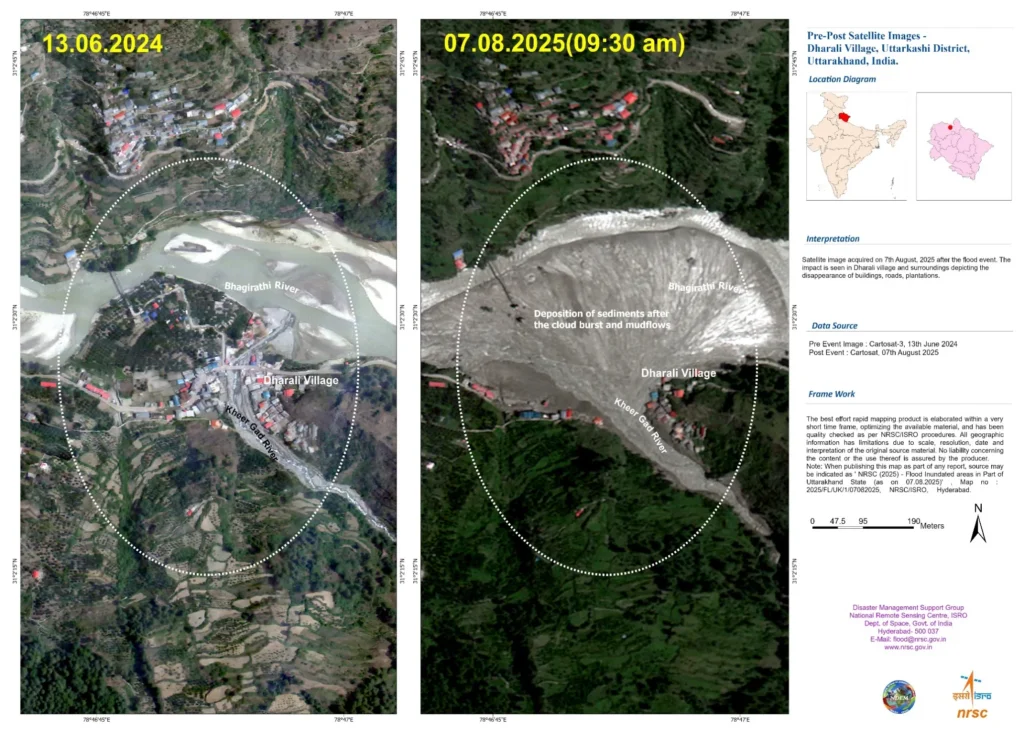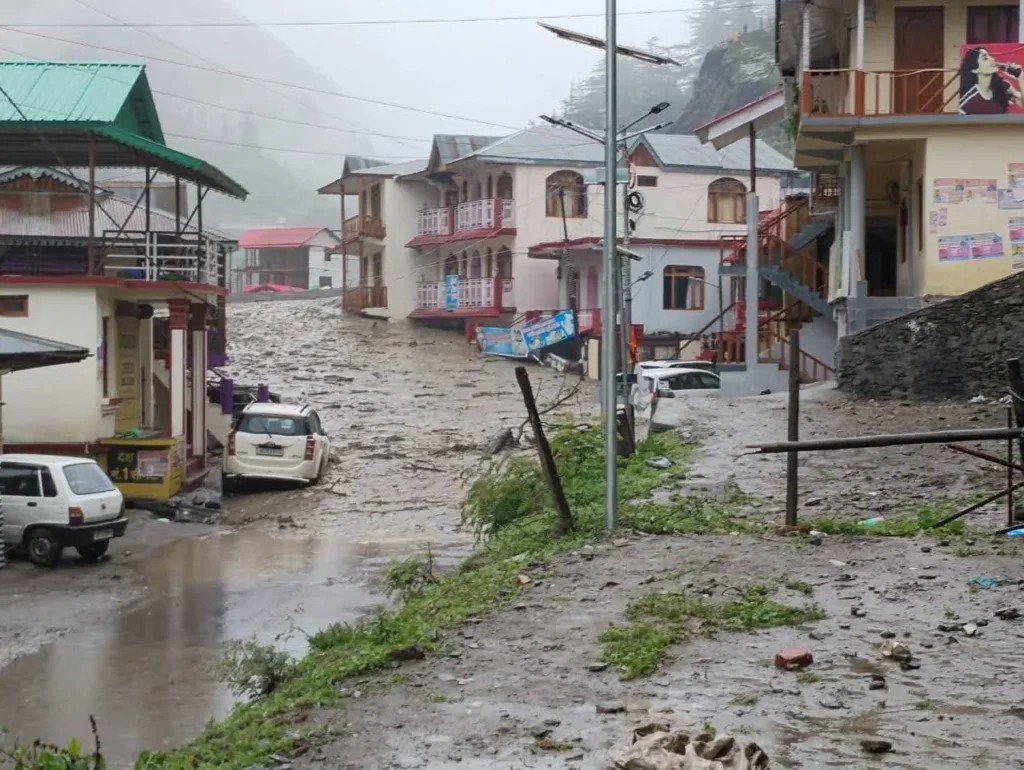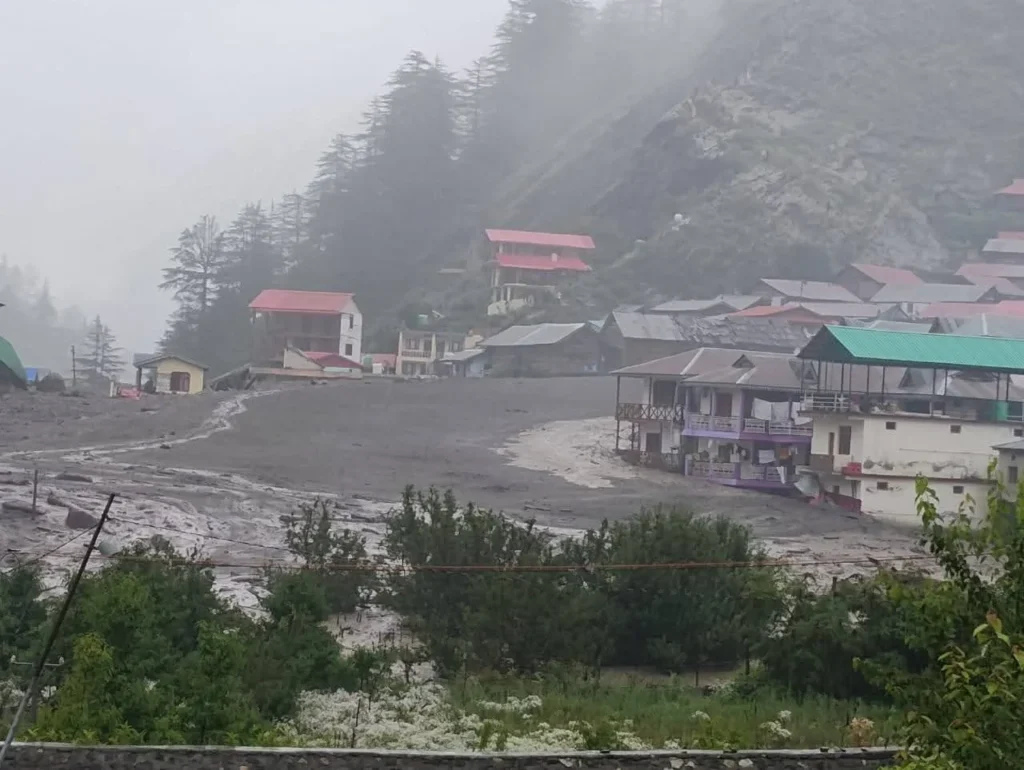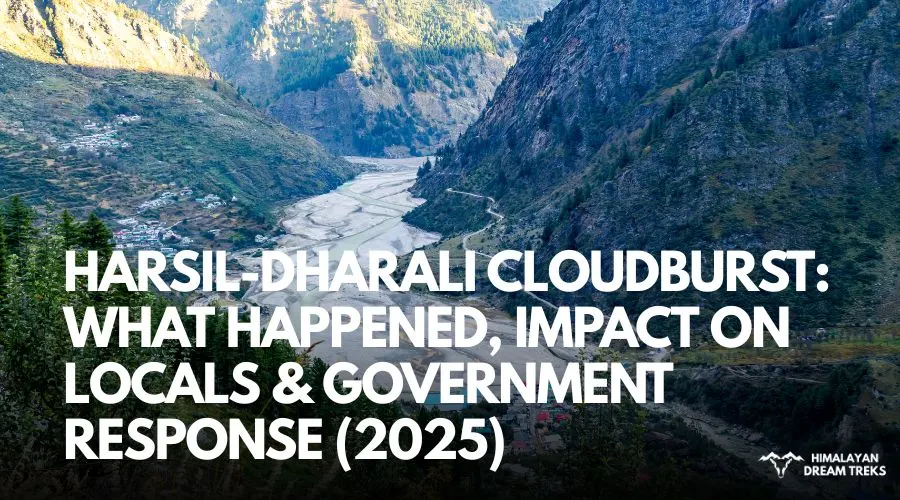The morning of August 5, 2025, began like any other in Dharali, a quiet Himalayan village near Harsil, about 20 kilometers from Gangotri, Uttarakhand.
The sky was calm, there was no significant rainfall, and tourists were preparing to trek or visit the temple trails. But what unfolded in just a few terrifying minutes left the region devastated.
A massive mudslide generated by what experts now believe was a Glacial Lake Outburst Flood (GLOF) or a glacier collapse crashed down the mountainside.
It destroyed homes, hotels, bridges, and army camps. Lives were lost, and dozens are still missing.
What was initially thought to be a cloudburst is now being called something even more serious: a disaster waiting to happen.

Cloudburst or Glacier Collapse?
Early reports speculated a cloudburst as the cause. However, scientists and experts analyzing rainfall data quickly challenged this theory.
Nearby areas like Harsil recorded only 6.5 mm of rain, Bhatwari 11 mm, and Uttarkashi a peak of 27 mm, not even close to cloudburst standards, which usually exceed 100 mm/hour.
Instead, satellite imagery and terrain analysis revealed a likely cause: a glacial lake or snout burst in the upper Himalayan region above Dharali.
A sudden break or overflow from the glacier could have released a tide of water, mud, and debris down the narrow valley, causing the flash flood.
According to glaciologists, a detached glacier segment or unstable moraine (debris after glacier) near the source of the Ganges River might have failed, sending a powerful surge downstream. This is known as a GLOF, and it’s becoming increasingly common due to
climate change and rising glacial melt.
The Human Cost: Lost Lives, Missing Families
The flood tore through the village with a force no one was prepared for. Concrete structures crumbled like matchboxes, while shops, homes, and hotels were flattened.

The human toll has been heartbreaking:
- 5 bodies have been recovered so far.
- 50+ people remain missing.
- Among them are 11 soldiers who were part of the first response teams.
- Many missing persons are tourists, and their families continue to search for answers.
What makes the situation more tragic is the near impossibility of rescue operations in the immediate aftermath. Massive mudslides and damaged roads made even reaching the village a challenging task.
The worst part? Many had no warning, just a deafening roar and a few seconds to run, if they were lucky.
A Village That Tried to Warn: The Mukhba Whistle Call
One of the most heart-wrenching yet inspiring parts of this tragedy comes from Mukhba, a village just above Dharali.
Locals there, noticing changes in the stream and landslide rumblings, began whistling and shouting warnings, a traditional alert method passed down for generations.
Their frantic whistles gave people in Dharali just 15 to 20 seconds to escape.
Thanks to this ancient system, dozens of lives were saved far more than any app or sensor alert could have achieved in that moment.
Roadblocks and Rescue: Struggles on Every Front
Rescue operations began immediately, but were slowed down by landslides and road collapses. The Rishikesh-Uttarkashi highway, the lifeline to the disaster zone was heavily damaged.
Access to the region has been heavily compromised:
- The road near Bhatwari (12 km before reaching Dharali) experienced a land subsidence.
- Rescue convoys and Army personnel were stranded from 4 AM to 11 AM, unable to move.
- Internet and mobile services were down up to 60 km from Dharali, causing panic among relatives trying to contact their loved ones.
Despite these challenges, emergency teams from the Army, NDRF, SDRF, and ITBP pressed on. Over 225 personnel were deployed with support equipment, including search radars and rescue dogs.
A Relentless Rescue Mission
Despite the difficult terrain and weather, over 225 Indian Army personnel, ITBP, SDRF, NDRF and BRO are on the ground, working around the clock.

Key developments so far:
- Over 200 people have been rescued, including 70 civilians
- Temporary shelters and relief camps are being set up.
- Military helipad at Harsil & civil helipad at Nelong are operational
- Search Radar team deployed at Tekla to locate missing persons
- Medical teams are addressing both physical and psychological trauma.
- The state government has promised compensation and aid to affected families.
- Critically injured are being airlifted to Dehradun and AIIMS Rishikesh.
- Sniffer dogs, radar equipment and drones are being used to locate missing individuals.
- A military helipad at Harsil and a civil helipad at Nelong are operational for air support. The Dharali helipad is still buried under mud and debris.
Stranded tourists in Gangotri have been provided medical aid, food, and shelter and efforts are underway to help them return safely.
Recurring Pattern of Disaster
Underlining Dharali’s vulnerability:
- Dharali marks years not by festivals but by floods, with past disasters in 2010, 2012, and 2018 that destroyed homes and orchards, though casualties were avoided then.
- Historical cloudbursts across Uttarakhand, including recent ones near Yamunotri in June 2025, also illustrate a worrying trend
Dharali’s tragedy wasn’t isolated; it was part of a recurrent crisis.
Char Dham Yatra Impact: Pilgrims Caught in the Crisis
A group of 28 pilgrims from Kerala, partway through their Char Dham Yatra, was initially feared missing. Fortunately, they were later found safe, sheltered in a military camp, and confirmed to be unharmed.
This underscores how closely the disaster intersected with the sacred pilgrimage routes, affecting devotees and locals alike.
Voices from the Ground: Pain, Fear, and Hope
Survivors describe the moment of disaster as something they never imagined. “It was like the mountain itself had cracked open,” said one local resident.
Another villager said, “We heard a loud rumble, then everything just disappeared.”
Tourists caught in the disaster have praised the locals for their swift response. “If it weren’t for the villagers who guided us out, we wouldn’t be alive today,” one rescued tourist told reporters.
These human stories are what truly capture the heartbreak and the bravery of Dharali’s people.
Development vs. Disaster: Are We Learning?
The Dharali-Harsil disaster has once again highlighted a deeper issue: unplanned construction and unchecked tourism in the Himalayan ecosystem
With new hotels, roads, and homes being built rapidly to attract tourists, the mountains are being carved open without considering geological stability. The delicate balance of nature in Uttarakhand is being disturbed and disasters like this are the result.
Experts have warned repeatedly that building in such ecologically sensitive zones without proper planning invites landslides, floods, and glacial hazards. Unfortunately, this tragedy is yet another example.
Political and Public Response
Leaders and environmentalists across India are now urging for long-term preventive action. Congress MP Priyanka Gandhi Vadra commented:
“Every year, whether it’s Himachal, Uttarakhand, or Wayanad we are witnessing disasters. We need a comprehensive national strategy for prevention, not just response.”
This call echoes among scientists, locals, and environmental groups who have been demanding stricter controls on hill development and a scientific, climate-resilient approach to tourism and infrastructure.
In Memory, In Resolve
What happened in Dharali was a tragedy,not just of lives lost, but of warnings ignored, planning overlooked, and nature’s balance disrupted.
Yet, amidst the sorrow, there were stories of courage locals warning others, soldiers sacrificing their lives, and rescue teams fighting landslides to save complete strangers.
Dharali should become a symbol of not just grief, but also of resolve. A wake-up call that we cannot afford to hit snooze on again.

Leave a Comment